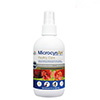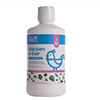Common Chicken Health Problems And Solutions
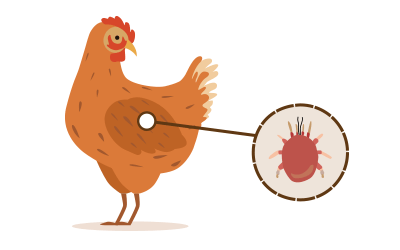
A chicken is a living creature and comes with its health issues. When observing your flock, always keep an eye on possible chicken health problems.
We’ll comment on some of the most common chicken health problems and the possible solutions to the problem.
First Aid for Chickens
It is important to remember that chickens are living creatures that face health problems. Constantly scratching the ground can result in foot problems or eye infections due to flying dirt, while bullying or pecking can lead to wounds. During cold winters, breeds with large combs are susceptible to frostbite. Additionally, parasite infections such as mites or lice are prevalent among poultry.
We suggest keeping a basic set of first-aid treatments and preventative measures in your home to address common issues. This way, you can treat your chickens promptly if any problems arise.
Although over-the-counter treatments may not always cure the problem, they can provide instant relief to your chickens, giving you time to seek veterinary assistance.
Common Chicken Health Problems:
- Hens that stop laying eggs
- Feather loss
- Foot problems
- Sour crop / Impacted crop
- Parasites
- Cannibalism
- Eye problems
- Egg abnormality
- Pasty vent
- Worms
- Fly strike
hens that stop laying eggs
Chickens that stop laying eggs are the most common chicken health issue for hens. There are many reasons why hens might be slowing down egg production. Some are innocent, like the chicken molt; others can be more dangerous.
Top 5 reasons for your hen to stop laying eggs:
- Chicken molt
- Lack of daylight
- Age
- Vitamin Deficiency
- Coop Environment and stress
Chicken molting
Every year during chicken molt, all chickens exchange their feather for new ones. This is a very uncomfortable and stressful time for your flock but a natural process, so it’s nothing to worry about. After molting time is over, they’ll start laying eggs again.
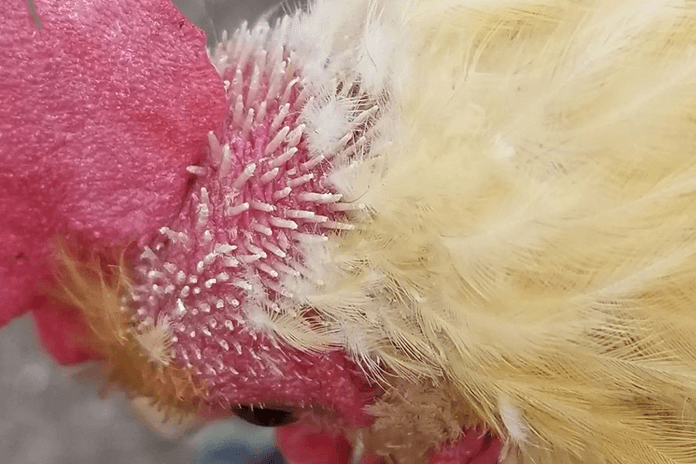
Lack of daylight
The second cause of hens stopping laying eggs is the lack of daylight. Hens need 14 to 16 hours of daylight to lay eggs, so this is why hens stop or reduce egg production during winter.
You don’t have to try and solve this by adding artificial light to the chicken coop during winter. When forcing hens to keep laying eggs can weaken their immune system.
Age
As hens get older, they reduce their egg production. They start laying eggs between 18-20 weeks of age and keep on laying until their body allows it. How old do chickens get? Hybrid chickens have a shorter lifespan than heritage breeds and most won’t live to be older than four years old.
Heritage breeds can get ten years and older.
A chicken’s retirement depends on chicken to chicken. Some chickens stop laying eggs as soon as a couple of years of age, others until the age of 7. Retired hens can still be valued members of your flock as they show younger birds the tricks of the trade.
Vitamin deficiency
Like humans, chickens can also develop vitamin deficiency when their diet isn’t that nutritious. They are incredibly picky eaters and only eat what they like the most. Many scratch mixes of chicken feed contain loads of fibers but almost no nutrients, and they encourage chickens to develop selective eating and eat whatever they want, not what they need.
Calcium is an essential nutrient to provide your hens. You can fix vitamin deficiencies by delivering them with pelleted feed or supplements. Consult a vet before you start treatment with supplements.
Coop environment and stress
When your hens are stressed, it could affect egg-laying production. Keeping your flock safe from predators is the first but crucial step to reducing stress levels. Other issues can be an overcrowded chicken coop, aggressive hens or roosters, or loud noises.
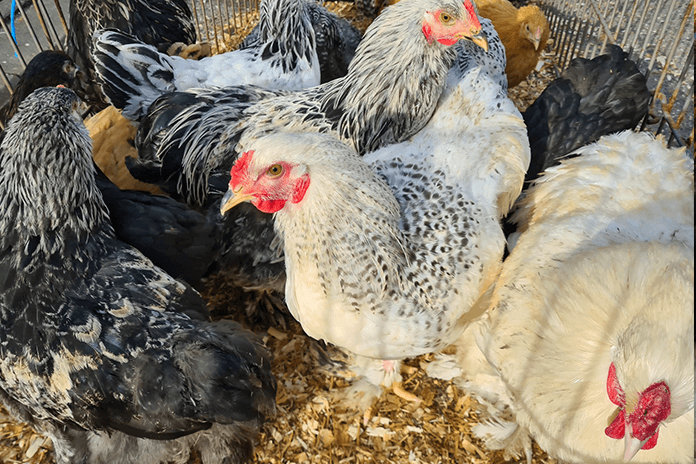
Other Reasons Why Hens Stop Laying Eggs
Less common but still not abnormal; when none of the reasons above apply to your hen, she might have caught a bacterial or viral disease like bronchitis, Marek’s disease, or even avian flu. Maybe she got infected with parasites. Treatment is possible; always consult your vet.
Feather Loss
What can cause feather loss?
- Chicken Molt
- Parasites such as mites, lice, ticks, and chiggers
- Boredom
- Stress
Chicken Molt
One of the most common reasons chickens lose their feathers is chicken molting. Molting occurs every year to chickens 16 months or older. Adult chickens shed their old feather coat in exchange for a new one.
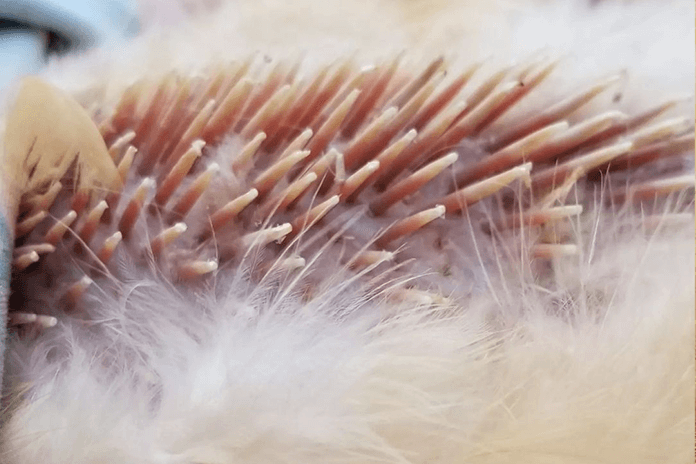
The duration of chicken molt depends from chicken to chicken, and your flock won’t probably mold at the same time. So if you have quite a large flock, molting time can last up to 2,5 to 3 months. Molting can make your chickens look a bit scrappy and unhappy, but it’s a natural process and not dangerous for them.
Parasites
Outside molting, the most common cause of feather loss is parasites. Common external parasites are lice, mites, ticks, and chiggers and will flock in the shafts of feathers, usually around the chicken’s vent as it is warm and moist. Parasites irritate, and your chicken will start scratching the areas infected.
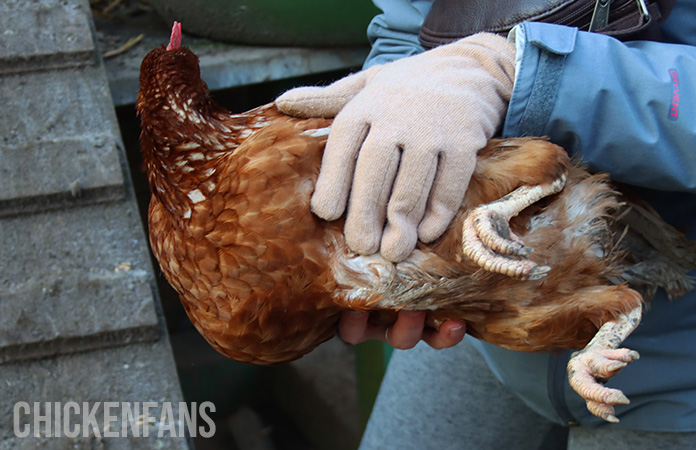
- Lice live on rejected skin cells outside the chicken’s body.
- Mites suck on the blood of their host and, when untreated, can cause serious health problems.
- Poultry ticks, or fowl ticks, thrive in chicken coops, conceal themselves daily, and feed at night. Tick bites can irritate the chicken’s skin, but worse, they can spread diseases.
- Chiggers are the larval stage of harvest mites that feast on skin cells and cause the chickens to keep scratching themselves.
- Scaly leg mites are microscopic critters that nestle under the keratin scales of a chicken’s legs and feet.
Boredom
Chickens are brilliant animals and should be challenged mentally to prevent boredom and get into mischief. There are many options to keep them entertained.
Install several dust baths inside the chicken run. Chickens clean themselves by getting dirty and love spending their time in the dust bath.
Make them ‘work’ for a nice snack. Chicken owners can make them hanging cabbages or cabbage pinatas. It’ll give them a workout while challenging them to a tasty snack. Just make sure you hang the cabbage low enough so they can reach it. Cabbage pinatas can be an excellent DIY project to do with your kids.
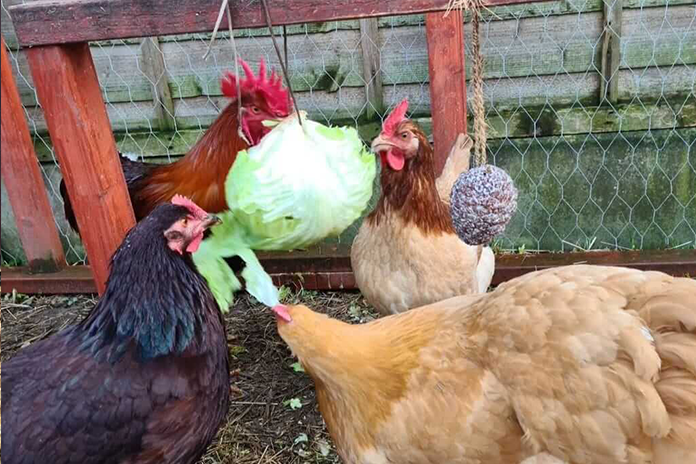
When you don’t have the time to make or are not into the DIY route, plenty of entertainment sets can be purchased online, like chicken swings, ladders, shredder toys, treat balls, and much more.
Stress
When hens get stressed out, the first thing they’ll do is stop laying eggs. So this can be your first clue to try and resolve this chicken health problem. When stress levels remain high, chickens will stop eating and lose feathers.
But how can you prevent your chickens from feeling stressed? It would be best to consider many things, like predator-proofing your chicken run or no loud noises near the chicken coop.
Things that cause stress are:
- Predators near the chicken coop
- Loud noises
- Chicken bullying
- Lack of food and water
- Change in routine and environment
Foot problems
Most common foot problems:
- Scaly Leg Mites
- Bumblefoot
- Gout
A lot of foot problems start with an infected wound. The result is that chickens don’t enjoy wandering around and take their time on the perches and in the nesting box.
Scaly Leg mites
The chicken leg mite is a pale gray, tiny parasite. Usually, leg mites attack older, weaker chickens but can also affect younger chickens when kept in the same coop. Leg mites hide under the scales on a chicken’s legs and feet. As a result, the legs and feet thicken and crust over, eventually becoming deformed.
Once chicken leg mites have found their way into the chicken coop and under the chicken’s skin, they’ll spend their entire life on that chicken, so getting rid of these kinds of mites is tough. It’s better to prevent than cure, so brush the chicken perches twice a month with a natural product called VetRx veterinary remedy.
How can you treat scaly leg mites? An effective cure is treating the leg and feet with a scaly leg remover. It contains active ingredients that kill the mite and soothes the legs and feet. Organic farmers can treat their chickens with natural repellents. Or you can use vaseline to smother the leg mites. The choice is yours.
Bumblefoot
A common condition is bumblefoot, where the foot is swollen and red due to a bacterial infection and occurs most in heavy breeds. It finds origin in the old English word ‘bumble,’ which means to walk unsteadily. Bumblefoot results when the skin is compromised somehow, and bacteria (like staphylococcus) can find their way in by cuts or open wounds, which leads to an abscess filled with puss.
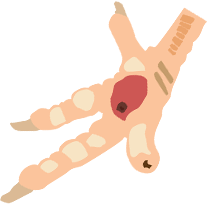
Chicken feet are constantly scratching the chicken coop and chicken run floor so they can get easily hurt. Therefore bumblefoot isn’t that uncommon but must be treated as soon as possible to prevent the infection from spreading.
Regular inspections of your flock’s feet are highly recommended to catch any possible infections at an early stage.
So how do you treat a chicken who has bumblefoot? An antibacterial spray like Banixx may help when caught in an early stageBanixx may help.
Regarding the treatment for more severe cases, we wouldn’t recommend taking any actions by yourself but always consult a vet. Your veterinarian can determine what bacteria has infected the wound and suggest an appropriate medical treatment.
Gout
Gout is a complex form of arthritis and a sign of significant kidney dysfunction. Some symptoms of gout can look like bumblefoot. There’s swelling and deformity seen on the chicken foot, so how can you determine whether it’s bumblefoot or gout?
Bumblefoot symptom is a single sore at the bottom of the foot and usually affects only one foot. While gout can affect both feet, your chicken has multiple sores, even between toes.
There is no sure cure for gout, unlike bumblefoot, so always consult your veterinarian.
Sour Crop / Impacted Crop
Crop issues are pretty common in chickens but are most of the time quite easy to cure when treated in time. The most common issues are sour crop and impacted crop. We’ll go over them one by one, but first, let’s find out what a chicken’s crop is.
What is a chicken’s crop?
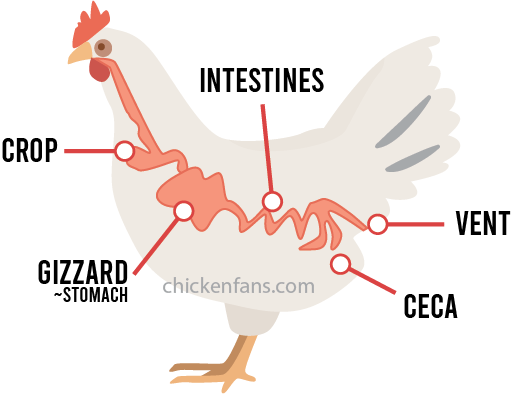
A chicken’s crop is a little pocket that buffers the food a chicken eats before it travels to the stomach. It allows the chicken to eat more than the stomach can process at once and it prevents the chicken from overeating by storing the food until the stomach empties. It’s normal for chickens to have a full crop after eating, but when their crop is full when they wake up, further investigation has to be done.
Sour Crop
Sour crop, or candidiasis, is a yeast infection of the chicken’s crop. Yeast organisms usually target chickens with a weaker immune system, like baby chicks, older chickens, or chickens with an underlying condition. The most characteristic symptom of sour crop is the development of white patches inside the crop, mouth, and vent area of a chicken. Severe infections can be fatal for chickens, and it’s essential to start treatment with antifungal medication as soon as possible. Milder cases, however, can be tackled by supplementing apple cider vinegar to the drinking water.
Impacted Crop
When a chicken’s crop gets blocked by food or after the intake of something undigestable, it can’t be emptied overnight anymore. Since food remains in the crop for a prolonged time, it’s a perfect breeding ground for the Candida yeast to multiplicate. That’s why impacted crop is a common precursor of sour crop.
When you see food stuck in your chicken’s throat, try to make the food slide towards the crop by drizzling water or olive oil into your hen’s mouth. You can help the food pass the throat by gently massaging your chicken’s neck. If this doesn’t help, consult a veterinarian, and don’t poke into your chicken’s beak with tweezers.
Parasites
Common parasites found on chickens:
- Lice
- Mites
- Poultry ticks or fowl ticks
- Chiggers
Lice
Poultry lice are different from the ‘usual’ head lice we know from children at school; they vary from yellow to brown. They spread by the close bird to bird contact and feed on rejected skin cells outside the chicken’s body. It’ll make them feel itchy and uncomfortable. How do you treat poultry lice? The easiest way is to provide a deep dust bath for your chickens containing garden soil and construction sand. For more severe infestations, you’ll need to use pyrethrin-based insecticides. Never use lice shampoos made for humans, as they will harm your chickens.
Mites
Mites suck on the blood of their host and, when untreated, can cause serious chicken health problems. To check your flock for mites, carefully lift the feathers and look for tiny grey dots on the skin of your chicken. It’s no secret that mites are less common in clean and well-kept coops. If your chickens take dust baths regularly, that helps keep them mite-free.
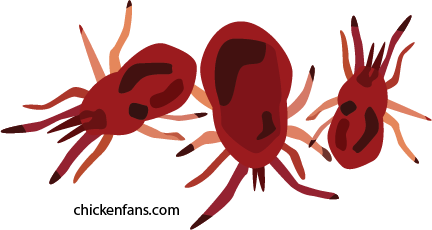
Poultry ticks or fowl ticks
Ticks are more common in warm climates or during summer. They thrive in chicken coops, conceal themselves daily, and feed at night.
Chiggers
Chiggers are the larval state of harvest mites that feast on skin cells and cause the chickens to keep scratching themselves. They catch chiggers by roaming grassy areas or come into contact with hay.
Cannibalism
This is probably the most disturbing chicken health issue that can happen to your flock. Unfortunately, it’s not that uncommon for chickens to eat flock members. There are different methods to prevent your chickens from turning to aggressive behavior or cannibalism.
- Food. Feeding your chickens chicken meat, raw or cooked, is not a good idea as it can turn them into cannibals. Also, keep them away from eggs or eggshells.
- Entertainment. Try and keep your chickens as entertained as possible. Provide dust baths (enough for the entire flock), teach them things (as chickens can be very intelligent), make them work for snacks by hanging a cabbage pinata or buy chicken toys like a swing, a ladder, play balls,…
- Bully in the flock. Some chickens can be real bullies, or worse, they can peck other chickens to death. Keep an eye on your chickens and their bully. If things are getting out of hand, separate the bully from the flock. Keep him (or her) apart for some time and introduce the bully back to the flock. If the bullying starts again, do the same thing but for a more extended period. That way, the bully will eventually lose his place in the pecking order and (hopefully) calm down.
Pinless peepers, or chicken blinders, are a very useful help to prevent aggressive behavior and feather pecking. The blinders are tiny plastic chicken glasses they wear on their nostrils. It looks a bit silly, but pinless peepers make it impossible for the chicken to look in front of them. By blinding what’s happening right in front of your chicken, chances of aggression towards other chickens get slimmer.
An antibacterial spray like Banixx can be a solution to treat pecking sores on your chicken.
Eye problems
Dirt, bacteria, or wounds can cause chickens’ eye problems. They are constantly scraping their feet and pecking, so it’s not that uncommon for them to run into occasional flying objects, like small rocks or dirt. This is normal chicken behavior, so preventing small things from getting into their eyes is impossible. Once you notice that your chicken’s eye is wounded, it will look cloudy or even bubbly. Contact a veterinarian, when in doubt.
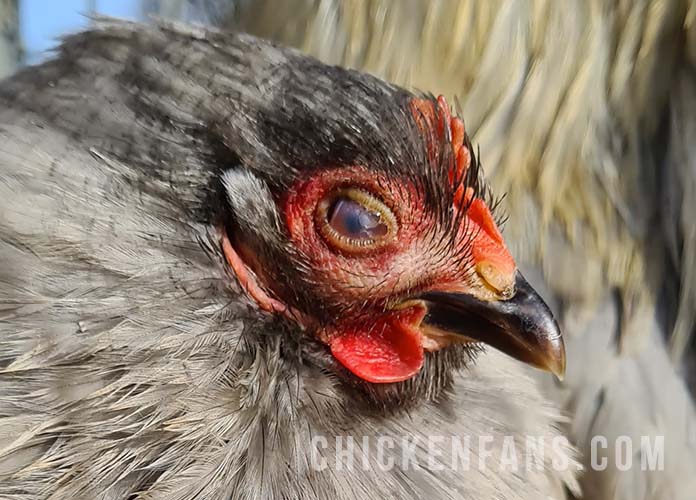
Egg Abnormality
Weirdly shaped or soft shell eggs are a well-known chicken health problem for poultry keepers. The eggs will come out with an abnormal shape, a fragile shell, or almost no shell. Misshaped eggs don’t have to be a problem when the shell is thick enough. Chances are your hen will start laying normal-shaped eggs in no time; keep an eye. But soft-shelled eggs are a more significant issue.
Why is my hen laying soft-shelled eggs?
- Age
- Malnutricion
- Calcium Deficiency
- Stress
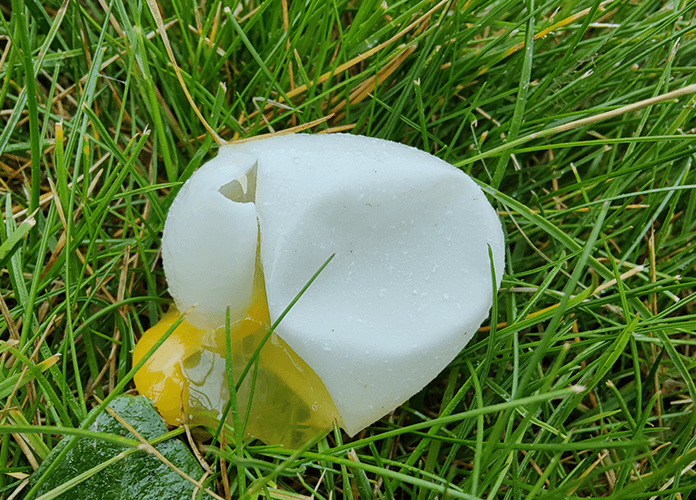
First of all, older hens are more likely to lay soft-shelled eggs due to their age. Not much we can do about that except change their diet. But for younger hens, laying soft-shelled eggs can also indicate malnutrition or lack of calcium. It can also signify stress due to hot weather or a heatwave.
When the eggshell is too thin, the egg can easily break during laying or just after. If the hen starts eating the eggs, it’s a tough habit to unlearn, and your hen will probably keep on doing it.
How to stop my hens from laying soft-shelled eggs?
Soft-shelled egg laying is often easily solved by changing your hen’s diet.
- Provide food with high calcium levels
- Give crushed oyster shells or crushed egg shells
- Avoid food that prevents calcium intake, such as citrus fruits, spinach, beet greens,…
- Provide clean water
Can you eat soft-shelled eggs?
The answer is NO. You can not eat soft-shelled eggs.
Eggshells’ only purpose is to keep bacteria outside the egg, so there is no way to ensure the egg is healthy and safe to eat. Dispose of any soft-shelled eggs as soon as possible.
Pasty Vent
Pasty vent, or pasty butt, is a typical chicken health problem with baby chicks. Their droppings clutter under their tail, blocking the vent and preventing the chick from passing any more droppings.
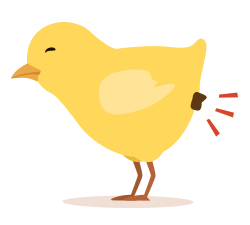
This is a widespread issue and easily cured when spotted early stage. So always keep an eye on your baby chicks, as they can be fatal when not treated.
How to spot pasty vent?
It’s effortless to spot pasty vent. Just flip the chick over and check the area right under the tail. When you see dried-up droppings, the chick has a pasty butt.
How to treat pasty vent?
Moisten a cue tip or a cotton swab with hot water to wipe away the dried poop and clear the vent. If that doesn’t suffice, carefully snip some of the droppings with a small pair of scissors. Be extra careful.
Worms
It’s not always easy to tell whether your chicken has parasitic poultry worms. Still, symptoms may include abnormal droppings (diarrhea), worms in eggs, worms in droppings, gasping for air, worms in troat, and severe cases resulting in weight loss.
Prevention is better than cure when it comes to parasitic worms, so make sure to keep your chickens healthy and the chicken coop clean. A clean and hygienic environment helps to keep a worm infestation away from your flock.
Fly Strike
During the summer months, flies are a widespread chicken health problem known to poultry keepers. They can infest your chicken flock with all kinds of diseases. But more importantly, flies are responsible for flystrike, a severe condition that will kill your chickens when left untreated.
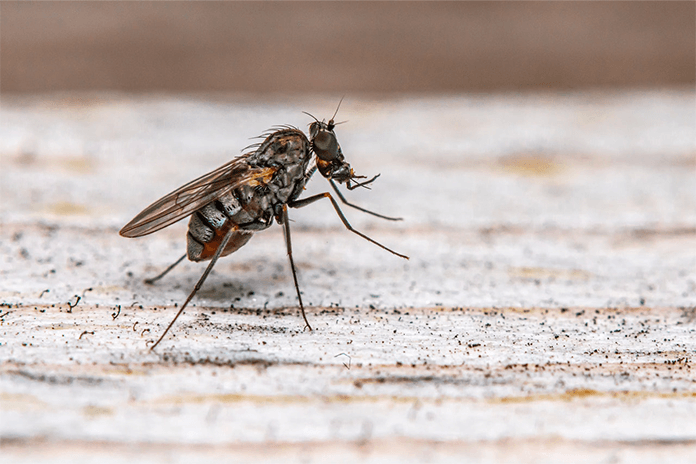
What is fly strike?
Flystrike occurs when flies lay eggs in the chicken’s vent area, where it’s warm and moist. After laying, the eggs turn into larvae after 8 to 12 hours. A fly can lay up to 150 eggs; that’s a lot of larvae on your chicken. The larvae need food, and the chicken flesh is their preferable lunch, dinner, and snack. So they start eating the meat of your chicken’s vent area, which causes a lot of pain to the bird. If left untreated, chickens can die from flystrike.
How to prevent and treat fly strike?
To prevent fly strike, you need to keep flies away from your chicken coop, but that’s easier said than done during summer. Therefore, try to check your chicken’s vent area at least once a week for fly eggs or larvae.
When spotting any signs of grubs, take action immediately by running a bath filled with warm (not hot) water and soaking the chicken’s vent area. With the use of a pair of tweezers, remove the maggots or fly eggs, every single one of them. It’s not the most pleasant chore, but your chicken will thank you later.
When all larvae are removed, clean the vent area with warm water and dry the feathers. Spray the dry feathers with an antimicrobial poultry spray like Banixx and repeat this process twice a day for at least one week to prevent a re-infestation.

